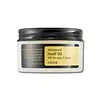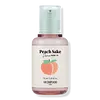What's inside
What's inside
 Key Ingredients
Key Ingredients

 Benefits
Benefits

 Concerns
Concerns

 Ingredients Side-by-side
Ingredients Side-by-side

Snail Secretion Filtrate
Skin ConditioningBetaine
HumectantCaprylic/Capric Triglyceride
MaskingButylene Glycol
HumectantCetearyl Olivate
Sorbitan Olivate
EmulsifyingCetearyl Alcohol
EmollientCarbomer
Emulsion StabilisingEthyl Hexanediol
SolventPhenoxyethanol
PreservativeArginine
MaskingDimethicone
EmollientSodium Polyacrylate
AbsorbentSodium Hyaluronate
HumectantAllantoin
Skin ConditioningPalmitic Acid
EmollientPanthenol
Skin ConditioningXanthan Gum
EmulsifyingStearic Acid
CleansingAdenosine
Skin ConditioningWater
Skin ConditioningMyristic Acid
CleansingSnail Secretion Filtrate, Betaine, Caprylic/Capric Triglyceride, Butylene Glycol, Cetearyl Olivate, Sorbitan Olivate, Cetearyl Alcohol, Carbomer, Ethyl Hexanediol, Phenoxyethanol, Arginine, Dimethicone, Sodium Polyacrylate, Sodium Hyaluronate, Allantoin, Palmitic Acid, Panthenol, Xanthan Gum, Stearic Acid, Adenosine, Water, Myristic Acid
Water
Skin ConditioningSilica
AbrasivePhenyl Trimethicone
Skin ConditioningCetyl Ethylhexanoate
EmollientIsohexadecane
EmollientPolymethyl Methacrylate
Hydrogenated Polyisobutene
EmollientDimethicone
EmollientPrunus Persica Fruit Extract
AbrasiveRice Ferment Filtrate
Skin ConditioningPolyglyceryl-3 Methylglucose Distearate
EmulsifyingSorbitan Stearate
EmulsifyingAlcohol Denat.
AntimicrobialButylene Glycol
HumectantSynthetic Fluorphlogopite
Cetearyl Alcohol
EmollientPropylene Glycol
HumectantCI 77891
Cosmetic ColorantCarbomer
Emulsion StabilisingTriethanolamine
BufferingSucrose Cocoate
EmulsifyingTocopheryl Acetate
AntioxidantMagnesium Aluminum Silicate
AbsorbentArgania Spinosa Kernel Oil
EmollientHydrogenated Lecithin
EmulsifyingEnantia Chlorantha Bark Extract
Skin ConditioningDisodium EDTA
Sesamum Indicum Seed Oil
EmollientStearyl Glycyrrhetinate
Skin ConditioningBeta-Sitosterol
Emulsion StabilisingSerenoa Serrulata Fruit Extract
Skin ConditioningGlycyrrhiza Glabra Root Extract
BleachingCentella Asiatica Extract
CleansingTocopherol
AntioxidantGlycine Soja Seed Extract
Skin ConditioningOleanolic Acid
Skin ConditioningChamomilla Recutita Flower Extract
MaskingPhenoxyethanol
PreservativeCeramide AP
Skin Conditioning1,2-Hexanediol
Skin ConditioningCI 17200
Cosmetic ColorantCI 19140
Cosmetic ColorantCI 15985
Cosmetic ColorantParfum
MaskingWater, Silica, Phenyl Trimethicone, Cetyl Ethylhexanoate, Isohexadecane, Polymethyl Methacrylate, Hydrogenated Polyisobutene, Dimethicone, Prunus Persica Fruit Extract, Rice Ferment Filtrate, Polyglyceryl-3 Methylglucose Distearate, Sorbitan Stearate, Alcohol Denat., Butylene Glycol, Synthetic Fluorphlogopite, Cetearyl Alcohol, Propylene Glycol, CI 77891, Carbomer, Triethanolamine, Sucrose Cocoate, Tocopheryl Acetate, Magnesium Aluminum Silicate, Argania Spinosa Kernel Oil, Hydrogenated Lecithin, Enantia Chlorantha Bark Extract, Disodium EDTA, Sesamum Indicum Seed Oil, Stearyl Glycyrrhetinate, Beta-Sitosterol, Serenoa Serrulata Fruit Extract, Glycyrrhiza Glabra Root Extract, Centella Asiatica Extract, Tocopherol, Glycine Soja Seed Extract, Oleanolic Acid, Chamomilla Recutita Flower Extract, Phenoxyethanol, Ceramide AP, 1,2-Hexanediol, CI 17200, CI 19140, CI 15985, Parfum
 Reviews
Reviews

Ingredients Explained
These ingredients are found in both products.
Ingredients higher up in an ingredient list are typically present in a larger amount.
Butylene Glycol (or BG) is used within cosmetic products for a few different reasons:
Overall, Butylene Glycol is a safe and well-rounded ingredient that works well with other ingredients.
Though this ingredient works well with most skin types, some people with sensitive skin may experience a reaction such as allergic rashes, closed comedones, or itchiness.
Learn more about Butylene GlycolCarbomer is a polymer of acrylic acid. Its main role is to create a gel consistency.
A high amount of carbomer can cause pilling or balling up of products. Don't worry, most products contain 1% or less of carbomer.
Cetearyl alcohol is a mixture of two fatty alcohols: cetyl alcohol and stearyl alcohol. It is mainly used as an emulsifier. Emulsifiers help prevent the separation of oils and products. Due to its composition, it can also be used to thicken a product or help create foam.
Cetearyl alcohol is an emollient. Emollients help soothe and hydrate the skin by trapping moisture.
Studies show Cetearyl alcohol is non-toxic and non-irritating. The FDA allows products labeled "alcohol-free" to have fatty alcohols.
This ingredient is usually derived from plant oils such as palm, vegetable, or coconut oils. There is debate on whether this ingredient will cause acne.
Due to the fatty acid base, this ingredient may not be Malassezia folliculitis safe.
Learn more about Cetearyl AlcoholDimethicone is a type of synthetic silicone created from natural materials such as quartz.
What it does:
Dimethicone comes in different viscosities:
Depending on the viscosity, dimethicone has different properties.
Ingredients lists don't always show which type is used, so we recommend reaching out to the brand if you have questions about the viscosity.
This ingredient is unlikely to cause irritation because it does not get absorbed into skin. However, people with silicone allergies should be careful about using this ingredient.
Note: Dimethicone may contribute to pilling. This is because it is not oil or water soluble, so pilling may occur when layered with products. When mixed with heavy oils in a formula, the outcome is also quite greasy.
Learn more about DimethiconePhenoxyethanol is a preservative that has germicide, antimicrobial, and aromatic properties. Studies show that phenoxyethanol can prevent microbial growth. By itself, it has a scent that is similar to that of a rose.
It's often used in formulations along with Caprylyl Glycol to preserve the shelf life of products.
Water. It's the most common cosmetic ingredient of all. You'll usually see it at the top of ingredient lists, meaning that it makes up the largest part of the product.
So why is it so popular? Water most often acts as a solvent - this means that it helps dissolve other ingredients into the formulation.
You'll also recognize water as that liquid we all need to stay alive. If you see this, drink a glass of water. Stay hydrated!
Learn more about Water